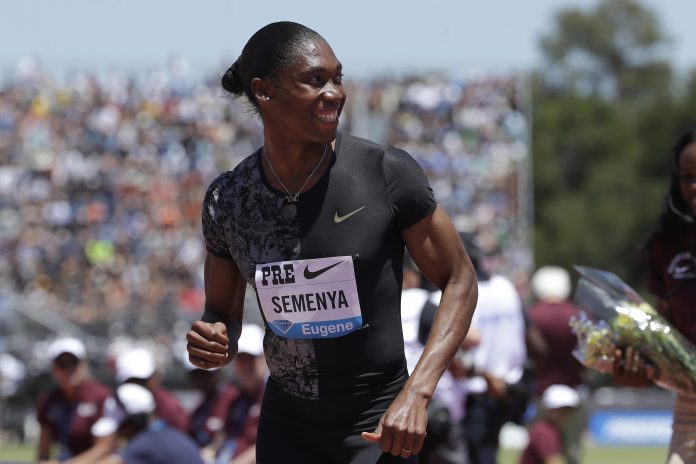
Banned from competing in her favorite race and defending her title, the Olympic 800-meter champion is trying to make the Tokyo Games anyway — by switching to the 200 meters.
Semenya announced her decision on her Instagram account on Friday, saying her desire “to compete at the highest level of sport” drove her to try to qualify for the Olympics in an unfamiliar race for her.
“This decision has not been an easy one but, as always, I look forward to the challenge and will work hard, doing all I can to qualify for Tokyo and compete to the best of my ability for South Africa,” she said.
Under the world track and field body’s highly criticized testosterone regulations, Semenya and other female athletes with high natural testosterone are barred from races from 400 meters to one mile at top-level meets like the Olympics and world championships unless they undergo treatment to reduce their hormone levels for six months prior to running.
Semenya has refused to do so, calling the rules and the medical intervention required unfair and unethical. Athletes are given three choices to lower their testosterone: birth control pills, hormone-blocking injections or surgery.
But the regulations don’t apply to the 200 meters and that gives Semenya a chance to run at her third Olympics, even if it’s not in the race she wants to run in.
It won’t be easy.
Semenya has rarely run the 200 meters, and only at lower-level events. She didn’t compete at all over the distance between 2016 and early 2019, and she is well off the pace of the world’s leading women.
The 29-year-old South African needs to improve her personal best by nearly two seconds just to qualify for the Tokyo Olympics. Her best is 24.26 seconds, in South Africa in February 2019. The Olympic qualifying standard for the women’s 200 is 22.80 seconds. Semenya’s PB wouldn’t have got her out of the heats at the 2016 Rio de Janeiro Olympics.
But at least Semenya has a goal now after being in limbo for nearly a year after making an unsuccessful appeal of World Athletics’ testosterone regulations at the Court of Arbitration for Sport last May.
That left Semenya with a choice: Submit to medical treatment to lower her testosterone or stay away from the 800 meters. Defiant, she chose to stay away and hasn’t run an 800-meter race since winning at the Prefontaine Classic in June last year, her 31st straight victory over two laps. She wasn’t able to defend her title at last year’s world championships.
Semenya’s decision to try the 200 may signal she has given up on her second legal challenge against the regulations. That second appeal is still being considered by the Swiss Federal Tribunal and a ruling is due in the coming weeks. She lost her first appeal at CAS last year by a 2-1 majority of the panel of judges.
A favorable decision from the Swiss supreme court could still overturn the testosterone rules and allow Semenya to compete in the 800 again without hormone-reducing treatment, but her chances of winning the appeal are seen as slim.
World Athletics’ new testosterone rules apply to female athletes like Semenya with conditions known as differences of sex developments (DSDs). Semenya was born with the typical male XY chromosome pattern but also female traits. She was legally identified as female at birth and has been identified as female her entire life, but World Athletics says she is “biologically male” — an assertion she has rejected angrily.
World Athletics says higher testosterone gives women like Semenya an unfair athletic advantage.
Semenya’s story has been one of the most contentious in sport ever since she arrived as an unknown teenager and won gold at the 2009 world championships amid a gender-test storm.
She has won two Olympic titles and three world titles in the 800 meters and is the reigning Olympic champion but has now been barred from running twice in her career. The first time she was sidelined by World Athletics, then known as the IAAF, was in 2009 in the wake of the gender controversy at the world championships.
Semenya hinted she might switch to the 200 when she won a rarely run 300-meter race and broke the South African record last month, her first race over any distance in eight months.
After that victory, she declared: “I’m here to stay. Track and field, you will still see my face.”



















